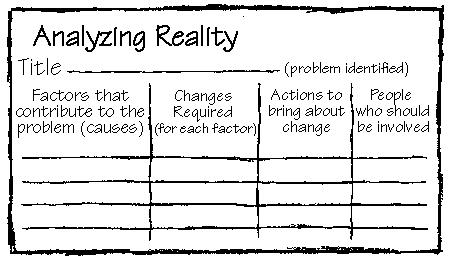
(senior high school students)


- To gain awareness of the interdependence of nations, of inequalities in the distribution of wealth, and of disparities in the area of development.
- To acquire an individual and collective sense of responsibility for the environment and development.
The students should discuss their definition of a sustainable future and the conditions needed to achieve it (see activity Defining a Sustainable Future, p. 12).
The students should discuss the different obstacles to sustainability in developing and in industrialized countries. What are the differing priorities for development in the North and the South?
The students form 8 teams representing one each of the main regions of the world: North America, Latin and South America, Western Europe, Eastern Europe, Asia, Africa, the Middle East and Oceania.
Using Rescue Mission, Agenda 21 and other resources, the students draw up a profile of the main environment and development realities and issues in their assigned region. The Agenda 21 summary on pages 16-21 and the Resources section on page 24 may be helpful. This profile can take the form of the observing reality example on page 14.

Each team offers the entire group a portrait of its assigned region. Differences and similarities between regions are discussed. Profiles could be enriched with visual aids or a guest speaker.The students develop consensus on some of the major global issues of environment, economy and society.
The students discuss the main factors which contribute to each issue, notably development policies and practices, and activities and attitudes of the population, governments, and industries.
Finally, students make a list of the changes that must take place on a global scale in the short and long term, if a sustainable future is to be a reality.
Students can use the Analyzing Reality example on page 15 to assist them in identifying changes and actions in their region.
The class should divide into groups to form Round Tables with the task of developing and recommending global strategies to contribute to solutions of one of the global issues which have been identified. The Round Tables should consist of members of the United Nations and representatives of different regions of the world, representing countries of the North and South.
Each group should present their recommendations and the class should develop consensus on their viability.
Finally, students can identify priority actions which could be taken at global and regional levels to begin to implement the recommendations.
It is important to remember that the negotiating process is not a competition to see who can give up the least (or most). This is a time for cooperation, for compromise and for a positive approach to the task of reaching a solution.

Students can organize an exhibit on the environment and development situation which prevails in the main regions of the world, and invite the public to attend.
Students can invite representatives of the regions examined to the school to give a first-hand account of their experience.
Students can draft articles or letters dealing with these issues and have them published in the student paper or local papers.
Students can invite representatives from groups concerned with environment and development issues to make lunch-hour presentations.
Share the summaries as well as the conference's conclusions via the SchoolNet.
Students can get involved with non-profit organizations that deal with environment and development issues.